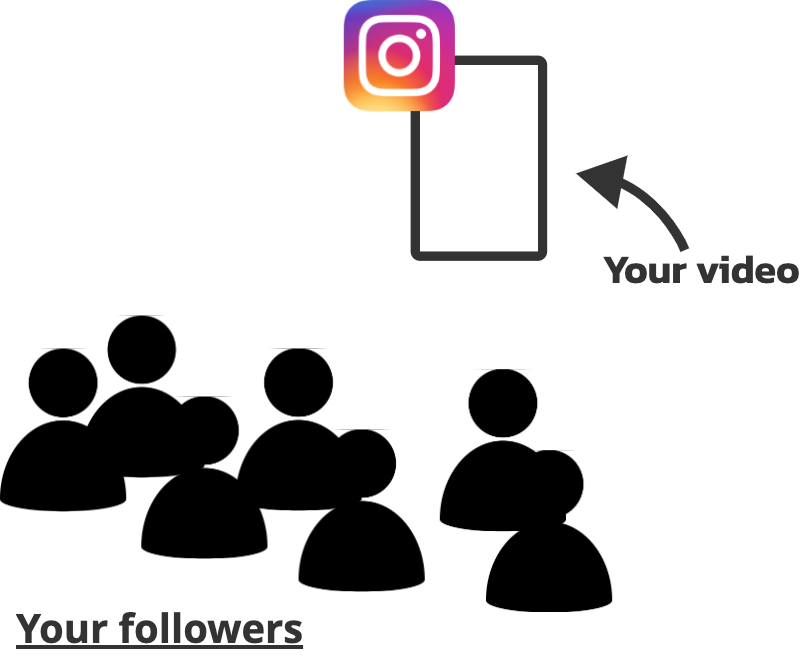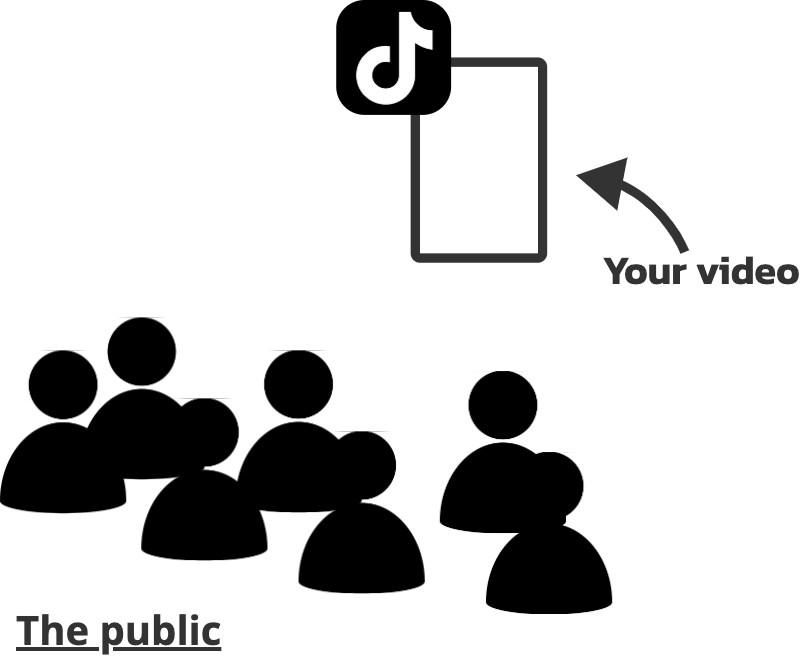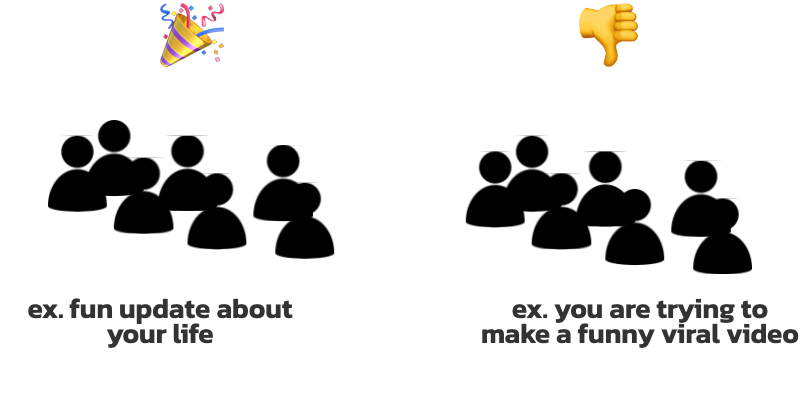Why your video gets different views on Instagram Reels and TikTok
You post the same video on TikTok and Instagram Reels, and one of them gets a lot of views while the other gets almost none. Why is that? It depends on how Instagram and TikTok view the concept of followers, and what the respective app uses as a test group for your new video. In this article, we explain exactly how this concept works and what really sets the apps apart.
Join the discussion
Do you disagree with the premise? Draw a different conclusion? Discuss this article and share your thoughts with others in one of our forums.
1. Same video. Different results.
When you post the same video on TikTok and Instagram Reels, you often get completely different results in terms of views. An obvious part of the explanation is that TikTok and Instagram have different users, with TikTok attracting many younger users. But we also have to consider how the apps differ when it comes to followers, and how the new For You Page that TikTok introduced changed how we use social media.

Image: If you post the same video on different apps, you can get very different results. Why is that?
2. The history of Instagram
Instagram has historically been about followers. You look up the people and accounts you want to see in your feed, and then you follow them and their content. You are in control of what you see. While Instagram has been introducing a new type of feed in the last years, with Reels, Explore and a never ending scroll feed that suggests new people outside of your network, we should still remember that Instagram has been prioritizing networks of people. Just like Facebook has done historically.

Image: Instagram has always been about followers. Follow someone to see their content.
3. The history of TikTok
TikTok, on the other hand, was created with the new concept of the For You Page. Which meant that you only needed to scroll, and content that you were interested in would appear in your feed automatically. You can still follow accounts on TikTok, but it isn't necessary for you to have a good experience in the app. The original way, where you looked up people and accounts and then followed them to see their content, became voluntary rather than necessary. This was all thanks to hypermodern algorithms that predict what you want to see.

Image: TikTok was created with the For You Page. You can follow someone but it isn't necessary. You'll see what you're interested in anyway.
4. The test group
When you publish a new video on any of the apps, the app needs to determine if your video is good or bad. If the video is good, it will be shown to more people. That's why a test group of people is needed, to whom the app shows your video and measures how good your video is, based on the viewers' behavior. Simply put, if we show the video to a few people and then measure how they react to the video, we can determine if the video is good or bad and then decide if we should continue to show the video to more people or not. This is the reasoning behind how many views you video will end up with and how viral it will be in the end.

Image: The app needs to determine if your video is good or bad. The app shows your video to a test group and measures their response.
5. The test group on Instagram
Since Instagram has historically been about followers, it's a reasonable assumption to believe that the first people who see your new Instagram Reel video are your followers. This has also been confirmed by Instagram. So it's essentially your followers who decide if the video should be shown to people outside of your network, and based on how your followers react to the video, their behavior affects how much the video will spread. We can confirm this by uploading a new Instagram Reel to an account with a few followers. It's clear that if you have, for example, 100 followers, a mediocre video might get around 50 views, and it takes a few days to reach that number of views. This is in line with the fact that your followers are your test group and that only a fraction of all followers will see the video. The fact that it takes a while or a few days for the views to increase is also an indication that your followers are the test group, because your followers are not online all the time. If the public had been your test group, there would always have been people online and the test would have been much faster.

Image: On Instagram, your followers are the test group
6. The test group on TikTok
For TikTok, on the other hand, the test group consists of randomly selected people around the country. It could be a collection of people who happen to be active at the moment you upload the video. We also see in the analysis tools that the people who see your video in the early stages are people in the same country as yourself. We can confirm this theory by uploading a new video to TikTok and study what happens. A new video on TikTok almost immediately jumps to around 300 views. Some videos remain at around 300 views, while others get more views as time goes on. This confirms that the test group is the public, because if you only have let's say 10 followers on TikTok, you usually still get 300 views on your video. You also get these views within an hour, and the likelihood that your followers would be online at that exact hour, regardless of the time of day, is unlikely. So it's the systematics of these results, that the new video is quickly tested on 300 people regardless of the time of day and number of followers, that is our indication that the hypothesis is correct.

Image: On TikTok, the test group is random people around the country
7. What to measure
To determine if your video is good or bad, the apps measure how the viewers in the test group react to your video. If the viewers watch the video for a long time and interact with it, the video will get more and more views. Viewers watching your entire video is an important metric for determining the quality of your video. If your video has a concluding part that no one watches, it's considered bad. But viewers watching your entire video isn't enough, so interactions are also measured. These can be the ones we see, such as likes and comments, or the ones you don't see, such as how many people read through your comment section. How viewers behave when watching your video is of course largely subconscious. If they are interested in the topic, they watch the video. However, when it comes to interacting, it also requires that the viewers want you to succeed. That they want you to do well. So the result depends on whether the test group wants you to succeed or not.
8. Content you share on Instagram
Since the test group on Instagram is your followers, who in most cases are also your friends, it will determine if your videos goes viral or not. Friends and strangers respond very differently to your content. For good and for bad. Think about how you react to your friends' content. If a friend posts an update about their life or something they're usually interested in and normally post about, you might respond in a certain way. But if your friend would suddenly very obviously want to try to go viral and posts a funny clip, you might be more skeptical and feel like the friend tries to take up too much air. So that's why your friends' reactions to your content determine whether it goes further and has the potential to go viral or not.

Image: On Instagram, your followers will like a certain type of content, but not all of your content.
9. Content you share on TikTok
On TikTok, where the public is your test group, different types of content can be more advantageous. Strangers often have no preconceived notions about you and no expectations of you or what type of content you post. A funny video, for example, can have much greater potential than a personal update about your life. Imagine yourself scrolling TikTok and seeing a video about someone getting engaged. If the engagement and the video itself aren't spectacular, you might not care much at all. They're strangers after all. But if someone has posted a video where they do something funny or entertaining, you might watch longer and be more likely to interact. Then you probably don't think as much about if the person takes up too much space or if the person is "cringe". It gives you a more objective view of the video, free from preconceived notions.

Image: On TikTok, the public has no preconceived notions about you.
10. Summary
The test group determines if your video goes viral or not, and who is part of the test group differs on Instagram and TikTok. Different types of content work differently depending on which app you publish them on. Content that, for example, is about personal updates from your life, can have more potential on Instagram than on TikTok. While branching out and trying new ideas, such as begin being funny and entertaining in your videos, can have more potential on TikTok than on Instagram.

Image: That's why the views differ for the same video.
Disclaimer
This post is an opinion of the author and does not necessarily reflect reality. We have no affiliation with the companies or brands we talk about, so our advice should be seen as qualified estimates rather than absolute truth, since we have not actually seen any code behind the apps. We base our advice on many years of experience as users of the apps, as well as on our knowledge of programming, research, mathematics and statistics. This helps us get an idea of how algorithms, apps and the data behind viral videos work.
Join the discussion
Do you disagree with the premise? Draw a different conclusion? Discuss this article and share your thoughts with others in one of our forums.
 Facebook group
Facebook group Reddit community
Reddit community





